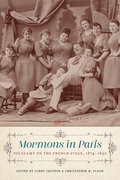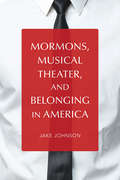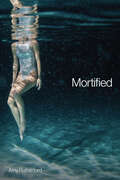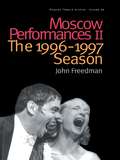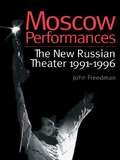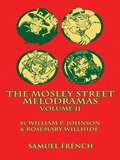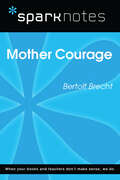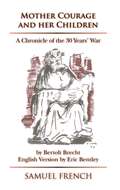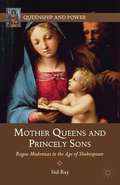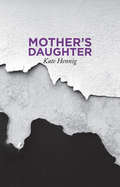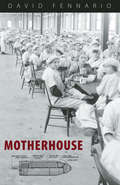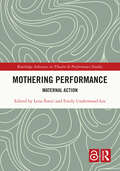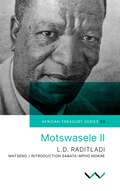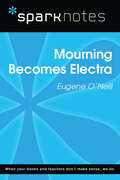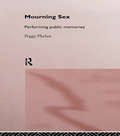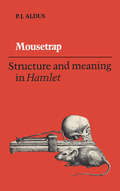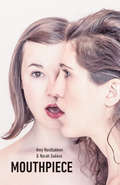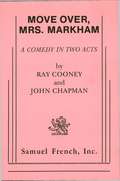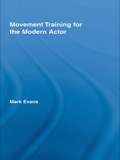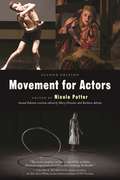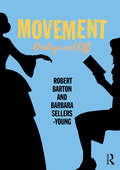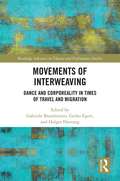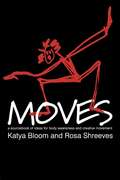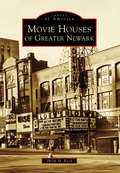- Table View
- List View
Mormons in Paris: Polygamy on the French Stage, 1874-1892 (Scènes francophones: Studies in French and Francophone Theater)
by Corry Cropper and Christopher M. FloodIn the late nineteenth century, numerous French plays, novels, cartoons, and works of art focused on Mormons. Unlike American authors who portrayed Mormons as malevolent “others,” however, French dramatists used Mormonism to point out hypocrisy in their own culture. Aren't Mormon women, because of their numbers in a household, more liberated than French women who can't divorce? What is polygamy but another name for multiple mistresses? This new critical edition presents translations of four musical comedies staged or published in France in the late 1800s: Mormons in Paris (1874), Berthelier Meets the Mormons (1875), Japheth’s Twelve Wives (1890), and Stephana’s Jewel (1892). Each is accompanied by a short contextualizing introduction with details about the music, playwrights, and staging. Humorous and largely unknown, these plays use Mormonism to explore and mock changing French mentalities during the Third Republic, lampooning shifting attitudes and evolving laws about marriage, divorce, and gender roles. Published by Bucknell University Press. Distributed worldwide by Rutgers University Press.
Mormons, Musical Theater, and Belonging in America (Music in American Life)
by Jake JohnsonThe Church of Jesus Christ of Latter-day Saints adopted the vocal and theatrical traditions of American musical theater as important theological tenets. As Church membership grew, leaders saw how the genre could help define the faith and wove musical theater into many aspects of Mormon life. Jake Johnson merges the study of belonging in America with scholarship on voice and popular music to explore the surprising yet profound link between two quintessentially American institutions. Throughout the twentieth and twenty-first centuries, Mormons gravitated toward musicals as a common platform for transmitting political and theological ideas. Johnson sees Mormons using musical theater as a medium for theology of voice--a religious practice that suggests how vicariously voicing another person can bring one closer to godliness. This sounding, Johnson suggests, created new opportunities for living. Voice and the musical theater tradition provided a site for Mormons to negotiate their way into middle-class respectability. At the same time, musical theater became a unique expressive tool of Mormon culture.
Mortified
by Amy RutherfordA woman runs into her former abuser and is surprised by the power he still holds over her. In an attempt to uncover the truth of what really happened between them, she recalls her adolescent self: a synchronized swimmer struggling to make sense of the world around her. Humorous and dark, Mortified explores sex, shame, and transformation and how we reckon with the traumatic experiences that have shaped us.
Moscow Performances II: The 1996-1997 Season
by John FreedmanThis is a collection of John Freedman's reviews and articles, most originally written for the Moscow Times, in which he focuses his expert critical eye on the directors, writers and actors who held centre stage during the 1996-97 theatre season in Moscow. The book looks at the debut of promising new artists and directors at the Moscow Art Theatre celebrating its 100th anniversary this year and offers a wealth of insight into the latest developments in Russian theatre. Freedman illuminates all of the season's noteworthy trends and events in clear, informed and unapologetically opinionated reports. More than just an overview of the stars and highlights, Moscow Performances II observes at close range the playhouses and the people who make up the ever-changing face of contemporary Russian theatre today. This volume is generously illustrated with photographs of featured productions and will be a useful reference for students, professors, writers, directors and actors in the fields of Russian studies, theatre studies, theatre history and contemporary culture.
Moscow Performances: The New Russian Theater 1991-1996 (Russian Theatre Archive Ser. #Vol. 12.)
by John FreedmanThe reviews and features collected in John Freedman's Moscow Performances bring to life the diversity, energy, and imagination of Russian theater as few books have done before. While focusing on the work of Moscow's leading directors - Pyotr Fomenko, Kama Ginkas, Valery Fokin, Anatoly Vasilyev, Konstantin Raikin, Sergei Zhenovach, Yury Lyubimov, and many others - also included in its review are key productions by many of the renowned guests who bring their art to the Russian capital. Essays on St. Petersburg's Lev Dodin (of the Maly Drama Theatre), Lithuania's Eimuntas Nekrosius, Georgia's Robert Sturua, and Germany's Peter Stein confirm that Moscow's position as a "theatrical mecca" has not diminished since Anatoly Lunacharsky coined the phrase in the 1920s. In addition to recording Freedman's immediate and opinionated responses to Moscow stage developments in the 1990s, Moscow Performances contains a wealth of information about the struggles and occasional triumphs of a new generation of talented but as yet unknown playwrights, the successes of the best actors, and the social and financial trends which have had such an impact on Russian theatre in the post-Soviet period.
Mosley Street Melodramas V2
by William P. JohnsonThe laughs never stop with this collection of four Holiday themed Melodramas. No holds are barred as television favorites to some traditional Christmas classics get skewered in these light-hearted parodies. Each show has a diverse set of characters designed to put a modern spin on the spirit of the Melodrama. CHEER for the heroic, but frustrated Prairie Magician. BOO the villainous land baron with the hypnotic hairpiece, and OOH-AAH the four young single ladies adjusting to life in Manhattan (Kansas). These interactive Melodramas are simple to produce and appeal to all types of groups. Both cast and audience alike will have an uproariously good time!
Mother Courage (SparkNotes Literature Guide Series)
by SparkNotesMother Courage (SparkNotes Literature Guide) by Bertolt Brecht Making the reading experience fun! Created by Harvard students for students everywhere, SparkNotes is a new breed of study guide: smarter, better, faster. Geared to what today's students need to know, SparkNotes provides: *Chapter-by-chapter analysis *Explanations of key themes, motifs, and symbols *A review quiz and essay topicsLively and accessible, these guides are perfect for late-night studying and writing papers
Mother Courage and Her Children
by Eric Bentley Bertolt BrechtDrama / 18m, 5f, extras / Interior, 5 Exteriors This German play was written in 1939 and was first produced in Zurich in 1941. In America, it was published in English right away (1941, by New Directions) but did not reach Broadway till 1963 - in a memorable production directed by Jerome Robbins and starring Anne Bancroft. It had, of course, by that time been produced to much acclaim all over the world. When Bertolt Brecht directed the play in Munich (1950), Eric Bentley, Assistant Director, at his bidding started to translate the play into English. He was eventually to make several different English versions of it. The most interesting of these is published here. It was a collaboration with the eminent French composer Darius Milhaud. Together they made this remarkable contribution to musical theatre.
Mother Queens And Princely Sons
by Sid RayThis study explores representations of the Madonna and Child in early modern culture. It considers the mother and son as a conceptual, religio-political unit and examines the ways in which that unit was embodied and performed. Of primary interest is the way mothers derived agency from bearing incipient rulers. By focusing on agency and authority, the book traces a pattern between the symbiotic unity of Madonna and Child and other influential, dimorphic concepts, what author Sid Ray calls 'accolated bodies, ' in early modern thought: the king's two bodies, marital coverture, and the doctrine of the hypostatic union of man and God in Christ, each with its variation on how the two bodies in question share authority. Attuned to Catholic historical and cultural reverberations of the Madonna and Child and debates about the origins of power, this book reassesses the mother-son unit, focusing on its inversion of conventional gender roles and potential to destabilize and redefine the ways in which gender and power operate. Ultimately, the book argues that representations of the mother-son unit contested Protestant patriarchal authority by offering meritocratic and egalitarian alternatives to established models of governance.
Mother's Daughter
by Kate HennigIn this stunning third part to Kate Hennig’s powerful Queenmaker series, England’s first queen regnant finds herself fighting xenophobia, religious nationalism, and strained familial bonds in the power struggle that dubs her Bloody Mary. Upon the death of King Edward VI, the thirty-eight-year-old princess Mary—daughter of Henry VIII and Katherine of Aragon—wrests the throne from Edward’s deemed heir. But Mary’s mother appears from the vaults of memory, and adamantly questions the motives of Mary’s cousin Jane and her half-sister Bess, despite Mary’s affection for them both. As the kingdom splits along Roman Catholic and Protestant lines, Mary walks a gauntlet of squabbling ethics and politics, and is forced to make some tough decisions. Should she execute her opponents before it’s too late, the way her father did? Should she scramble to find a husband who can give her a rightful heir? And can she trust her mother, her sister, or even herself?
Mother's Love
by Fernando Pérez RodríguezA young single mother unexpectedly learns that her eight-year-old son is fighting for his life. She will do whatever it takes, both possible and impossible, to try to save her little one's life. Mother's Love is a novel about love, struggle and overcoming, one that will set your pulse racing and even bring a tear or two. Discover the limit of a mother's love for her son when his life is in danger!
Motherhouse
by David Fennario"When a final analysis is made of twentieth-century Canadian theater, the most significant political playwright will undoubtedly be David Fennario."--Canadian Book ReviewThis powerful drama gives a voice to the disillusioned working-class women employed at the British Munitions Factory in Verdun, Quebec, during World War I. Despite tension over conscription, dedicated mothers, wives, sisters, and sweethearts assemble artillery shells to support the war effort. Meanwhile, their beloved soldiers die abroad and their children starve at home because of war profiteers.David Fennario is an award-winning playwright and performer whose plays have been widely produced as well as televised on the Canadian Broadcasting Corporation.
Mothering Performance: Maternal Action (Routledge Advances in Theatre & Performance Studies)
by Lena Šimić Emily Underwood-LeeMothering Performance is a combination of scholarly essays and creative responses which focus on maternal performance and its applications from a variety of interdisciplinary perspectives. This collection extends the concept and action of ‘performance’ and connects it to the idea of ‘mothering’ as activity. Mothering, as a form of doing, is a site of never-ending political and personal production; it is situated in a specific place, and it is undertaken by specific bodies, marked by experience and context. The authors explore the potential of a maternal sensibility to move us towards maternal action that is explicitly political, ethical, and in relation to our others. Presented in three sections, Exchange, Practice, and Solidarity, the book includes international contributions from scholars and artists covering topics including ecology, migration, race, class, history, incarceration, mental health, domestic violence, intergenerational exchange, childcare, and peacebuilding. The collection gathers diverse maternal performance practices and methodologies which address aesthetics, dramaturgy, activism, pregnancy, everyday mothering, and menopause. The book is a great read for artists, maternal health and care professionals, and scholars. Researchers with an interest in feminist performance and motherhood, within the disciplines of performance studies, maternal studies, and women’s studies, and all those who wish to gain a deeper understanding of maternal experience, will find much of interest.
Motswasele II
by Leetile Disang RaditladiMotswasele II, the first historical drama written by a Botswanan author, originally published in the Bantu (later, African) Treasury Series by the University of the Witwatersrand Press, in 1945, Leetile Disang Raditladi explores the concept of chieftainship and what it means to be a good chief through the characters of two powerful men, Moruakgomo and Motswasele. According to the history of the Bakwena, the two men vied for the throne. Raditladi critiques the tyranny of Motswasele, whose actions are those of a greedy dictator with no regard for his people. His iron-fisted rule, disregard for advice from his council, and the fact that he helps himself to his subjects’ cattle at will cause great unhappiness. He surrounds himself with untrustworthy people who are not of royal blood and know nothing about power. In contrast, Moruakgomo is portrayed as a true leader who is caring, brave, wise, visionary and not above taking advice.In the drama, Motswasele is cautioned against wronging people he may need in the future, and being swayed by false songs of praise. Motswasele II highlights the importance of traditional rule, and the need for a chief to dispense power judiciously and to resolve conflicts where these arise.
Mourning Becomes Electra (SparkNotes Literature Guide Series)
by SparkNotesMourning Becomes Electra (SparkNotes Literature Guide) by Eugene O'Neill Making the reading experience fun! Created by Harvard students for students everywhere, SparkNotes is a new breed of study guide: smarter, better, faster. Geared to what today's students need to know, SparkNotes provides: *Chapter-by-chapter analysis *Explanations of key themes, motifs, and symbols *A review quiz and essay topicsLively and accessible, these guides are perfect for late-night studying and writing papers
Mourning Sex: Performing Public Memories
by Peggy PhelanThis is a book about the exhilaration and the catastrophe of embodiment. Analyzing different instances of injured bodies, Peggy Phelan considers what sustained attention to the affective force of trauma might yield for critical theory. Advocating what she calls "performative writing", she creates an extraordinary fusion of critical and creative thinking which erodes the distinction between art and theory, fact and fiction. The bodies she examines here include Christ's, as represented in Caravaggio's painting The Incredulity of St Thomas, Anita Hill's and Clarence Thomas's bodies as they were performed during the Senate hearings, the disinterred body of the Rose Theatre, exemplary bodies reconstructed through psychoanalytic talking cures, and the filmic bodies created by Tom Joslin, Mark Massi, and Peter Friedman in Silverlake Life: The View From Here. This new work by the highly-acclaimed author of Unmarked makes a stunning advance in performance theory in dialogue with psychoanalysis, queer theory, and cultural studies.
Mousetrap: Structure and Meaning in Hamlet
by P. J. AldusThere is scarcely an element of Hamlet that has not received attention many times, yet both general reader and sophisticated critic would generally agree that the character of Hamlet and the full meanings of the play remain mysteries. No less a puzzle is the art of Hamlet, for, while the form of the art is elusive, the feeling of essential meaning is strong. Professor Aldus hopes to enlarge our understanding of Hamlet and our appreciation of Shakespeare as a conscious artist of great subtlety by studying the play's dramatic structure in the light of Aristotle's Poetics and its meaning as literary myth in the light of Plato's Phaedrus. This is a study of Hamlet as literary myth, a figurative mode of art in which structure is basic; yet primal myth, myth in the larger, non-literary sense, becomes part of it too, because the substance of Hamlet seems to be of this kind. Professor Aldus's reading of Hamlet is both radically new and decidedly provocative. A great deal of very careful inquiry has gone into the unearthing of connections which at first sight often seem improbable and tenuous, but which, one comes to find, have an illuminating total unity. Future commentators may not accept all that Professor Aldus has to say about, for example, Ophelia's crown of flowers, but they will hardly be able to ignore it.
Mouthpiece
by Norah Sadava Norah Sadava Amy NostbakkenWinner of the 2017 Toronto Theatre Critics Award for Best New Canadian PlayWinner of three Dora Mavor Moore AwardsStage Award for Best Performance, 2017 Edinburgh Festival FringeMouthpiece follows one woman, for one day, as she tries to find her voice. Two performers express the inner conflict that exists within a modern woman's head: the push and pull, the past and the present, the progress and the regression. Interweaving a cappella harmony, dissonance, text, and physicality, Mouthpiece is a harrowing, humorous, and heart-wrenching journey into the female psyche.
Move Over, Mrs. Markham
by John Chapman Ray CooneyComedy / 4m, 5f / Combined set / To Sylvie it's the "goose" that she learned from Alistair, but to Philip, Joanna Markham's husband, it's "a variety of geese," and fifteen years of marriage is just about undone along with everything else in this wild zany free for all. Everything from Philip's business deals with Bow Wow Books and Alistair's near escape from Joanna's chiding seduction to the naked G.P.O. girl and the specter of scandal is hilarious. A lot of bedhopping occurs as Sylvie winds up taking Alistair on "walkies" and the amazing Mrs. Markham gets her man her husband! It all takes place in an elegant top floor London flat.
Movement Training for the Modern Actor (Routledge Advances in Theatre & Performance Studies)
by Mark EvansThis book is the first critical analysis of the key principles and practices informing the movement training of actors in the modern era. Focusing on the cultural history of modern movement training for actors, Evans traces the development of the ‘neutral’ body as a significant area of practice within drama school training and the relationship between movement pedagogy and the operation of discipline and power in shaping the professional identity of the actor. The volume looks in detail at the influence of the leading figures in movement training — Laban, Alexander, Copeau and Lecoq — on twentieth century professional actor training, and is informed by interviews with students and staff at leading English drama schools. Mark Evans re-evaluates the significance of movement training in the professional drama school, offering a new understanding of the body as a site for performative resistance to industrialization. Despite the publication of a number of ‘how to’ books on movement training for the professional acting student, this is the first text to look behind the curtain and write the unseen biography of the actor’s body.
Movement for Actors
by Barbara Adrian Nicole Potter Mary FleischerIn this updated rich resource for actors, renowned movement teachers and directors reveal the physical skills needed for the stage and the screen. Readers will gain remarkable insights into the physical skills and techniques used in a wide variety of performance styles through ready-to-use exercises and approaches. Included in this new edition are chapters covering:Stage combatYoga for actorsMartial artsBody-mind centeringAuthentic movementBartenieff fundamentalsGrotowski-based movementThose who want to pursue serious training will be able to consult the appendix for listings of the best teachers and schools in the country. This inspiring collection is a must-read for all actors, directors, and teachers of theater looking for stimulation and new approaches.Allworth Press, an imprint of Skyhorse Publishing, publishes a broad range of books on the visual and performing arts, with emphasis on the business of art. Our titles cover subjects such as graphic design, theater, branding, fine art, photography, interior design, writing, acting, film, how to start careers, business and legal forms, business practices, and more. While we don't aspire to publish a New York Times bestseller or a national bestseller, we are deeply committed to quality books that help creative professionals succeed and thrive. We often publish in areas overlooked by other publishers and welcome the author whose expertise can help our audience of readers.
Movement: Onstage and Off
by Robert Barton Barbara Sellers-YoungMovement: Onstage and Off is the complete guide for actors to the most effective techniques for developing a fully expressive body. It is a comprehensive compilation of established fundamentals, a handbook for movement centered personal growth and a guide to helping actors and teachers make informed decisions for advanced study. This book includes: fundamental healing/conditioning processes essential techniques required for versatile performance specialized skills various training approaches and ways to frame the actor’s movement training. Using imitation exercises to sharpen awareness, accessible language and adaptable material for solo and group work, the authors aim to empower actors of all levels to unleash their extraordinary potential.
Movements of Interweaving: Dance and Corporeality in Times of Travel and Migration (Routledge Advances in Theatre & Performance Studies)
by Gabriele Brandstetter Gerko Egert Holger HartungMovements of Interweaving is a rich collection of essays exploring the concept of interweaving performance cultures in the realms of movement, dance, and corporeality. Focusing on dance performances as well as on scenarios of cultural movements on a global scale, it not only challenges the concept of intercultural dance performances, but through its innovative approach also calls attention to the specific qualities of "interweaving" as a form of movement itself. Divided into four sections, this volume features an international team of scholars together developing a new critical perspective on the cultural practices of movement, travel and migration in and beyond dance.
Moves: A Sourcebook of Ideas for Body Awareness and Creative Movement
by Katya Bloom Rosa ShreevesFirst Published in 1998. The aim of this book is to reawaken awareness of the body feels; rekindle imagination; provide starting points for both developing greater self-awareness and creating expressive movement. 'Moves' suggests a wealth of exercises which stem from the natural movement of the body and are therefore accessible to anyone. As you respond to the material in this book you may notice changes in yourself, such as greater physical and emotional freedom, a lessening of anxiety and constriction, a new found sense of flow, flexibility and strength and a greater responsiveness to others and to the environment.
Movie Houses of Greater Newark (Images of America)
by Philip M. ReadFor decades, Newark and its environs have been lit up by the bright neon lights of grand movie palaces and theaters. In the early 20th century, stages that were originally built for vaudeville acts were turned over to silver screens and the flickering images from motion-picture projectors. This new technology ushered Hollywood movies to the East Coast and made cinema accessible for locals to enjoy. Movie houses and palaces provided moviegoers a new type of viewing experience. With ornate interiors and rich architecture, these institutions offered their patrons a beautiful setting to watch classic films. Over time, these establishments evolved and began hosting burlesque shows and rock concerts. Today, many of these downtown landmarks have been demolished, replaced, or adaptively renovated into the modern multiplexes of today. Images of the Paramount and the Mosque Theater help Movie Houses of Greater Newark tell the story of an era when going to the movies was an event.
